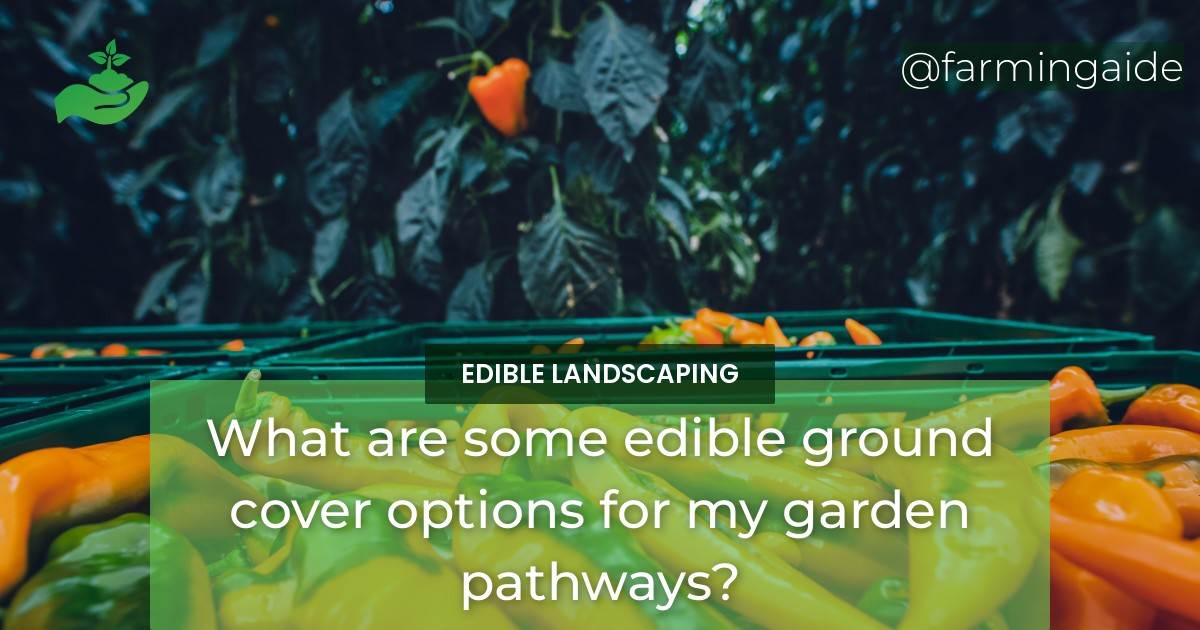Are you looking for a way to make your garden pathways not only beautiful but also edible? If so, then you may want to consider using edible ground cover plants. These low-growing edibles are not only functional but also add an attractive touch to your garden. In this article, we will discuss some of the best edible ground cover plants for garden pathways that you can grow and enjoy.
Creeping Thyme
If you’re looking for a fragrant and attractive ground cover, then you can’t go wrong with creeping thyme. This herb is a popular choice for garden pathways as it not only looks great but is also easy to maintain. Here are some of the characteristics of creeping thyme:
- Appearance: Small leaves and tiny flowers that bloom in pink or purple hues during the summer months.
- Growth habits: Creeps along the ground and spreads quickly, rooting as it goes.
Here are some of the culinary uses of creeping thyme:
- Flavoring for soups and stews
- As a seasoning for meat dishes
- Used in tea blends
If you’re interested in growing creeping thyme as a ground cover, here are some tips:
- Plant in well-drained soil and full sun or partial shade
- Water regularly, but avoid over-watering as it can cause root rot
- Trim regularly to keep it from getting too woody
Chamomile
Another great option for an edible ground cover is chamomile. This herb is known for its calming properties and is often used in tea blends. Here are some of the characteristics of chamomile:
- Appearance: Small white flowers with yellow centers
- Growth habits: Spreads quickly and can grow up to six inches tall
Here are some of the culinary uses of chamomile:
- Making tea blends
- Flavoring for desserts and pastries
- Used in herbal remedies for its calming properties
If you’re interested in growing chamomile as a ground cover, here are some tips:
- Plant in well-drained soil and full sun or partial shade
- Water regularly, but avoid over-watering as it can cause root rot
- Trim regularly to keep it from getting too woody
ALSO READ
Corsican Mint
If you’re looking for a fragrant and attractive ground cover, then Corsican mint might be the right choice for you. Here are some of the characteristics of Corsican mint:
- Appearance: Small leaves and tiny purple flowers
- Growth habits: Spreads quickly and can grow up to two inches tall
Here are some of the culinary uses of Corsican mint:
- Used as a flavoring in cocktails and desserts
- Added to salads and other dishes for its minty flavor
- Used in herbal remedies for its calming properties
If you’re interested in growing Corsican mint as a ground cover, here are some tips:
- Plant in well-drained soil and full sun or partial shade
- Water regularly, but avoid over-watering as it can cause root rot
- Trim regularly to keep it from getting too woody
Creeping Rosemary
Another great option for an edible ground cover is creeping rosemary. This herb is popular for its fragrance and culinary uses. Here are some of the characteristics of creeping rosemary:
- Appearance: Small leaves and tiny blue flowers
- Growth habits: Creeps along the ground and can grow up to one foot tall
Here are some of the culinary uses of creeping rosemary:
- Flavoring for meat dishes
- Used in marinades and rubs
- Added to bread and other baked goods for its flavor and aroma
If you’re interested in growing creeping rosemary as a ground cover, here are some tips:
- Plant in well-drained soil and full sun
- Water regularly, but avoid over-watering as it can cause root rot
- Prune regularly to keep it from getting too woody
ALSO READ
Other Edible Ground Cover Options
Aside from the four options discussed above, there are other edible ground cover plants that you can consider. Here are some of them:
- Wild strawberries
- Creeping thyme
- Wintergreen
- Creeping Jenny
- Irish moss
- Sweet woodruff
How can I incorporate edible ground cover into my garden pathways?
Incorporating edible ground cover into garden pathways can add both beauty and functionality to the space. Some ideas for edible plants integration include creeping thyme, strawberries, and mint. These plants not only provide a lovely scent and visual appeal but also serve as a practical and delicious addition to your outdoor space.
Conclusion
Edible ground cover plants are not only functional but also add an attractive touch to your garden pathways. By using these stepable plants, you can create a beautiful and functional garden that not only looks great but also provides you with fresh herbs and other edibles. So why not give it a try and grow one or more of the recommended options?
RELATED ARTICLES:


